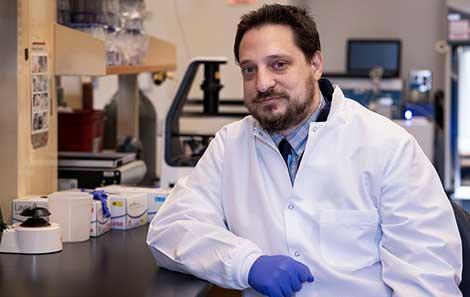UVA Health researchers discovered a possible first-ever treatment for atrophic age-related macular degeneration (dry AMD), the cause of irreversible blindness in nearly 200 million people worldwide.
Bradley D. Gelfand, PhD, and a team of researchers at UVA Health have found evidence that the popular antidepressant drug fluoxetine, commonly known as Prozac, could prevent or slow the progression of dry AMD.
Currently, there are no FDA-approved treatments for dry macular degeneration.
“These findings are an exciting example of the promise of drug repurposing – using existing medicines in new and unexpected ways,” says Gelfand.
Combined Research Methods
The UVA researchers made this exciting discovery using a novel 3-pronged approach:
- Testing in the lab
- Conducting disease-relevant animal models
- Reviewing two huge insurance databases
The UVA researchers believe fluoxetine works by affecting a part of the immune system called inflammasomes. They found that the fluoxetine binds to a specific inflammasome, NLRP3-ASC, and prevents it from affecting the macula.
Prozac Most Promising For AMD Among Drugs Tested
Along with fluoxetine, Gelfand and his team tested eight other depression drugs in lab mice. Fluoxetine was the only one that slowed the progression of the disease. Specifically, they showed that fluoxetine prevents the death of retinal pigmented epithelium cells.
Following that, the researchers tracked fluoxetine use among American patients over age 50 in two insurance databases. These databases contained information for about 100 million American patients. They found that patients taking fluoxetine for clinical depression had a significantly slower rate of developing dry AMD.
AMD Clinical Trials Now Needed
Based on these findings, the researchers are advocating for clinical trials testing the effectiveness of fluoxetine to treat AMD. “Ultimately, the best way to test whether fluoxetine benefits macular degeneration is to run a prospective clinical trial,” notes Gelfand.
The researchers’ findings and a discussion of their approach was published in the Proceedings of the National Academy of the United States of America (PNAS).
Faster Way to Tap Common Drugs’ Therapeutic Potential
Gelfand and his team believe that their multipronged research approach could help uncover new uses for other existing drugs. They’re hopeful that this combined method will help new treatments be discovered more quickly.
“Traditional approaches to drug development can be expensive and time-consuming,” noted the researchers. “On average, a new FDA-approved drug takes 10 to 12 years and costs $2.8 billion (present-day dollars) to develop. Our identification of the unrecognized therapeutic activity of an existing FDA-approved drug using big data mining, coupled with demonstrating its efficacy in a disease-relevant model, could greatly accelerate and reduce the cost of drug development.”
“It is tempting to think about all the untapped therapeutic potential of medicines sitting on pharmacy shelves,” says Gelfand.

